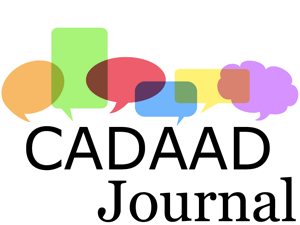GENERAL FORMATTING
- Indent new paragraphs with tabs, no blank lines
- Avoid inserting empty paragraphs to format page layout, etc.
- Do not insert empty lines after section headings
- 12 pt Times New Roman, 1.15 line spacing and 2.54 cm margins all around
- Include page numbers only as footer
- Maximum 8000 words, excluding notes and references
We only accept contributions in MS Word. No PDF, please.
ARTICLE INTRODUCTION
Each article should contain the following items on a separate page:
- Title: Subtitle (please use short titles)
- Name(s) of the author(s)
- Author(s) affiliation(s) and email of corresponding author
- Abstract (no more than 200 words)
- Key words (no more than five key words separated by commas)
- Author’s Declaration of Originality: “We/I the author(s) hereby certify that this paper is original and results from our/my own research. It does not infringe upon anyone’s copyright nor does it violate any proprietary rights. It will not be submitted for publication elsewhere during the reviewing procedure.”
STRUCTURE
Sections should be structured following the numerical system which means 1. or 1.1. or 1.1.1. Only sub-sections up to the third level are accepted (hence no 1.2.3.1).
ENDNOTES
Please do not use the footnotes or endnotes function. Rather, include a separate section Notes preceding the Reference section and add the notes manually.
FIGURES (INCL. TABLES AND IMAGES)
All figures should appear in the article and should be captioned and numbered consecutively throughout the article, with one line space above and below. Captions for Tables should be placed above the Table and Figure captions appear below the Figure.
DATA PRESENTATION
When presenting linguistic data (e.g. letters, words, or phrases), please distinguish it from the body of your text with italics. Please use quotation marks when glossing or explaining the presented linguistic feature. For example:
The quantifier many means ‘a lot’.
You may also set quoted sentences apart from the main body of the text by using numbered examples, indented, for example:
Consider the quantifier many and the expression hit the target in sentences (10) and (11):
(10) Not many arrows hit the target.
(11) Many arrows didn’t hit the target.
When working with non-Anglophone data, please present the text in italics and provide its English translation in square-brackets:
John then said: Je ne sais pas si je lui ai fais mal. [I don’t know if I hurt him.]
If you are presenting detailed transcripts (e.g. those used in a conversation analytic framework), please send a PDF of the transcript and indicate in the text which file that the copy-editor should insert (e.g. Insert Transcript 1 here). This will avoid any unwanted modifications of the transcripts while sending the file. Please do not forget to add a section specifying the Transcript Conventions.
QUOTATION AND IN-TEXT REFERENCING
PUNCTUATION
-
- Short quotations should appear in the main text in single quotation marks (e.g. ‘…’).
- Quotations within quotations take double quotation marks(e.g. “…”).
- Quotations longer than 3 lines should be indented in the text without quotation marks (use the appropriate style in the Word template). Don’t add the reference after the quote but before it.
- Keep quotation marks before any other punctuation mark.
QUOTING SOURCES:
Please follow the APA7 Author-Date style of referencing.
APA quick guide to in-text referencing:
- Author’s name is given in brackets: use commas between author and date. For example:
Metaphors are ideological in so far as they ‘can contribute to a situation where they privilege one understanding of reality over others’ (Chilton, 1996, p. 74).
- Author’s name is integrated into the text:put the date (and page number) of the source in brackets after the author’s name. For example:
According to Fowler (1991, p. 25), ‘representation, in the press as in all other kinds of media and discourse, is a constructive practice’.
More details of in-text author-date referencing below.
- Quoting from an Internet page: put ‘[online]’ instead of the page numbers. For example:
According to Pittman’s discourse (2013: [online]), …
- Modify parts of the quote: use square bracketsto indicate modifications. For example:
‘Extracts from Scarlett’s diary […] showed how [he …] was left in the care of Lobo’.
- Quote from a video: write the time-span referred to in (minutes:seconds) and present the time between square brackets. For example:
(YouTube, 2017, [08:43])
Details of APA in-text author-date referencing
- Single authors:
(Baker, 2008; Wodak, 1996; Teo, 2000)
- Multiple works by same author:
Racism has been a focus of CDA (van Dijk, 1987, 1991, 1993).
- Two authors should appear with an & if they are in-between brackets, or ‘and’ if the names belong to the text:
(Weinblum & Iglesias, 2013; Baker & Levon, 2016; etc.)
or
Weinblum and Iglesias (2013) point out that …
- More than 2 authors should appear with ‘et al.’ after the first author’s name:
(Baker et al., 2008; Frosh et al., 2001; etc.)
- References quoted in another source should appear with a colon between the two sources and they should be listed in the references section:
(Looker et al., 2007, quoted in O’Connor, 2010, p. 768)
REFERENCE LIST (AT THE END)
Format: Please use extra line spacing between the references (1.5) and indent each reference after the first line (hanging indent).
Style: Please follow the APA 7 style of referencing. A short-list of style examples is available here. Examples of how to reference textual, audio-visual and online sources can be found on this webpage.
We encourage the addition of DOI codes at the end of the sources in the following format: https://doi.org/10.1111/josl.12134
- When referencing computer software, please use the following style:
Anthony, L. (2014). AntConc (3.4.3). [Computer Software]. Tokyo: Waseda University. Available from: www.laurenceanthony.net.
